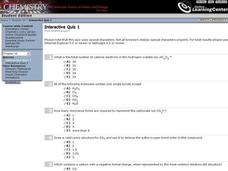Curated OER
Chemical Bonding
Students classify compounds as ionic or covalent. For this chemical bonding lesson plan, students experiment with 6 chemical compounds. They test physical properties such as the melting point, the solubility and the electrical...
Curated OER
Bonding Basics Review
In this bonding worksheet, students complete a chart of elements, their symbols, the total number of electrons, the number of valence electrons and the oxidation numbers. They draw Lewis structures for atoms and show the transfer of...
Curated OER
AP Chemistry Atomic Structure-7 Worksheet
In this atomic structure instructional activity, students solve twelve problems related to wavelength, frequency, electron transitions, emission spectra and quantum number.
Curated OER
Finding the Oxidation State
In this oxidation state worksheet, students are given rules for assigning oxidation numbers and a chart showing the oxidation states of the elements of a given compound. Students use the rules and the example to find the oxidation states...
Curated OER
What do Atoms Look Like?
In this atoms worksheet, students complete 58 questions about the atomic radius of atoms, the ionization energy, the valence electrons, metals, non-metals and semi-metals and the families of elements.
Curated OER
Water - the (Nearly) Universal Solvent
In this water worksheet, learners explore the reasons why water is considered a universal solvent. Students compare different ways to change the dissolving rate of a solute. This worksheet has 11 fill in the blank and 8 matching questions.
Curated OER
Empirical Formulas
In this empirical formulas learning exercise, students read about determining empirical formulas from chemical formulas. They determine the empirical formula given ten molecular formulas. They also find the molecular formulas given the...
Curated OER
What do Atoms Look Like?
In this atom activity, students complete 60 questions about the trends in atoms such as ionization energy and atomic radius, about valence electrons, about the families of elements, about metals, non-metals and semi-metals, about the...
Curated OER
What Do Atoms Look Like?
In this atomic structure worksheet, students answer eleven short answer questions about the structure of atoms including the number of protons, neutrons and electrons. Students indicate the differences in isotopes of atoms and what the...
Curated OER
The Effects of Temperature on Chemical Mixtures
Students explore chemical cahnges and the effect of temperature on chemical mixturees, They make observations of the behavior and appearance of certain chemical mixtures and reactions.
Curated OER
The Case Of The Sour Employee
Ninth graders are presented with a problem that has to be solved. The scenario is a mystery that is purely hypothetical. This does draw on the knowledge of previous lessons. The lesson plan contains background knowledge explaining the...
Curated OER
The Moon's Atmosphere
In this moon's atmosphere learning exercise, students read about the tenuous lunar atmosphere and solve 4 problems. They find the density of helium particles, they find the grams of given atoms in the moon's atmosphere and they find the...
Curated OER
Naming Compounds
In this compounds worksheet, students use a flowchart to determine what a compound is made of and how to name the compound. Students complete 6 matching and 60 fill in the blank questions.
Curated OER
Writing and Balancing Equations
In this equations worksheet, students identify simple reactions as direct combination, decomposition, single replacement, or double replacement. This worksheet has 20 fill in the blank questions.
Curated OER
Identifying Reaction Types
In this reactions worksheet, students are given nine chemical reactions to identify as single replacement, double replacement, synthesis or decomposition reactions.
Curated OER
Naming Compounds
In this naming compounds worksheet, high schoolers are given a chart to determine if the compound they are naming is ionic, covalent or polyatomic. Students practice identifying and naming ionic, covalent and polyatomic compounds. They...
Curated OER
The Difference Between Acids and Bases Using Different Indicators
Learners identify the differences between acids and bases. In this acids and bases lesson plan, students identify and distinguish between acids and bases. They use household products to test the ph levels. They test the ph levels by...
Curated OER
Chemical Composition of American Coins
Students investigate the chemical composition of pennies dated 1983 or later. In this chemical composition of American coins lesson plan, students scratch the surface of the penny to expose the zinc core. They put the penny in...
Curated OER
Chemistry and Bonding
In this bonding worksheet, students take an interactive quiz with 15 multiple choice questions about the VSEPR Theory, bonding, the geometry of molecules, Lewis structures, resonance structures and enthalpy changes.
Curated OER
How Do Atoms Stick Together?
For this chemical bonding worksheet, students answer 76 questions about compounds, Lewis dot structures, intermolecular forces between atoms, electronegativity and bonding and types of bonds.
Curated OER
The Halogens
In this chemistry activity, students answer 24 questions related to properties of halogens. They fill in the table with the correct answers and participate in teacher demo.
Curated OER
pH and Red Cabbage Juice
Young scholars review properties of materials and define what pH tells them about matter. In this pH levels lesson, students determine whether materials are acids or bases using indicator substances.
Curated OER
Sense of Scale
Middle schoolers examine the pH scale. They research common products and determine their pH level. They create their own pH scale and place their products in the appropriate place.
Curated OER
Atoms and the Periodic Table
Familiarize your new chemists with the periodic table of elements by contemplating this collection of slides. Element groups are identified, atoms are defined, and nuclide notation is explained. Isotopes are also mentioned. The topics...

























